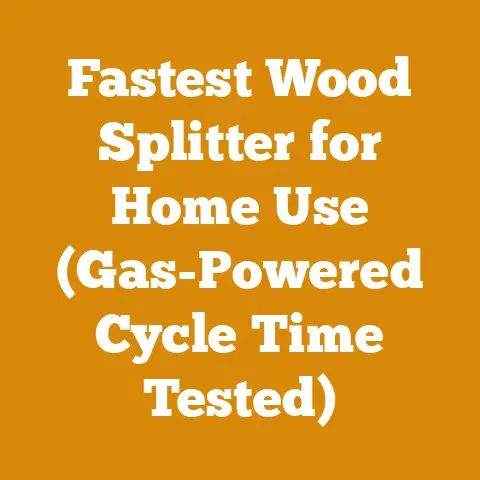Mini Excavator Stump Grinder (5 Pro Tips for Efficient Wood Processing)
Imagine this: You’re standing at the edge of a freshly cleared lot.
Stumps, like stubborn teeth, litter the landscape.
You need to clear them efficiently, and a mini excavator with a stump grinder attachment seems like the perfect solution.
But is it really that simple?
Can you just hop in and start grinding, or are there nuances to master for truly efficient wood processing?
I’ve spent years working with excavators and stump grinders, from small-scale backyard projects to larger land-clearing operations.
I’ve learned a lot of hard lessons along the way.
In this guide, I’ll share my top five pro tips to help you maximize your productivity and safety when using a mini excavator stump grinder.
Mini Excavator Stump Grinder: 5 Pro Tips for Efficient Wood Processing
Let’s dive into those tips.
I’ll cover everything from proper technique and machine maintenance to safety considerations and choosing the right equipment.
My goal is to equip you with the knowledge you need to tackle any stump grinding project with confidence.
1. Choosing the Right Stump Grinder Attachment
Selecting the right stump grinder for your mini excavator is crucial.
It’s not a one-size-fits-all situation.
The size and type of stumps you’ll be tackling, as well as the hydraulic flow rate of your excavator, will dictate the optimal attachment.
Understanding Stump Grinder Types
There are primarily two types of stump grinder attachments for mini excavators:
- Wheel Grinders: These use a rotating wheel with teeth around the perimeter to grind the stump.
They are typically faster for larger stumps and offer a more aggressive cut. - Planer Grinders: These use a rotating planer head with multiple cutting edges.
They are better for smaller stumps and offer a smoother, more controlled grinding experience.
Matching Grinder to Excavator Hydraulic Flow
Hydraulic flow is measured in gallons per minute (GPM).
Your excavator’s hydraulic system needs to deliver the appropriate GPM to the stump grinder for optimal performance.
Too little flow, and the grinder will be sluggish and inefficient.
Too much flow, and you risk damaging the grinder’s motor.
Check your excavator’s specifications and the stump grinder’s requirements.
I once made the mistake of pairing a high-flow stump grinder with a lower GPM excavator.
The grinder barely spun, and I wasted an entire day trying to figure out what was wrong.
Learn from my experience!
Stump Size and Density Considerations
Consider the average size and density of the stumps you’ll be grinding.
For small to medium-sized stumps (up to 18 inches in diameter) and softer woods like pine or poplar, a planer grinder might suffice.
For larger stumps (over 18 inches) and hardwoods like oak or maple, a wheel grinder is generally more efficient.
Key Takeaway
Choose a stump grinder attachment that is properly sized for your excavator’s hydraulic flow and the types of stumps you’ll be grinding.
Research and confirm compatibility before making a purchase.
2. Mastering the Grinding Technique
Proper grinding technique is just as important as having the right equipment.
It’s not about brute force; it’s about finesse and understanding how the grinder works.
The “Sweep and Plunge” Method
I’ve found the most effective method to be what I call the “sweep and plunge.” Here’s how it works:
- Position the Grinder: Position the stump grinder slightly above the stump, angled towards the center.
- Sweep: Slowly sweep the grinder across the surface of the stump, removing a thin layer of wood with each pass.
- Plunge: After each sweep, lower the grinder slightly and repeat the sweep.
This gradually grinds the stump down. - Overlap Passes: Overlap each sweep slightly to ensure complete coverage and avoid leaving ridges.
Controlling the Feed Rate
The feed rate is the speed at which you move the grinder into the stump.
Too fast, and you risk bogging down the grinder or even damaging it.
Too slow, and you’re wasting time.
The ideal feed rate depends on the type of wood, the size of the stump, and the power of your grinder.
Start slow and gradually increase the feed rate until you find the sweet spot where the grinder is cutting efficiently without bogging down.
I remember one time, I was so eager to finish a project that I pushed the grinder too hard.
The engine stalled repeatedly, and I ended up spending more time troubleshooting than grinding.
Patience is key!
Grinding Below Ground Level
To completely remove a stump, you’ll need to grind it below ground level.
This allows you to backfill the hole with soil and replant grass or other vegetation.
I usually aim to grind the stump down at least 4-6 inches below the surface.
This ensures that there are no remaining roots or debris that could interfere with future landscaping.
Dealing with Rocks and Debris
Rocks and debris are the enemy of stump grinders.
They can damage the teeth and even shatter the grinder wheel.
Before you start grinding, carefully inspect the area around the stump and remove any visible rocks or debris.
If you encounter a rock while grinding, stop immediately and remove it.
Key Takeaway
Master the “sweep and plunge” method, control the feed rate, and be vigilant about rocks and debris.
These techniques will significantly improve your grinding efficiency and prolong the life of your equipment.
3. Maintaining Your Equipment
A well-maintained stump grinder is a productive stump grinder.
Neglecting maintenance can lead to breakdowns, reduced performance, and costly repairs.
Daily Inspections
Before each use, perform a thorough inspection of the stump grinder. Check the following:
- Teeth: Inspect the teeth for wear, damage, or looseness.
Replace any worn or damaged teeth immediately. - Hydraulic Hoses and Fittings: Check for leaks, cracks, or damage. Tighten any loose fittings.
- Guards and Shields: Ensure that all guards and shields are in place and properly secured.
- Grease Points: Grease all grease points according to the manufacturer’s recommendations.
Regular Maintenance Tasks
In addition to daily inspections, perform regular maintenance tasks according to the manufacturer’s recommendations.
These may include:
- Sharpening Teeth: Sharpen the teeth regularly to maintain optimal cutting performance.
Dull teeth will slow down the grinding process and put unnecessary strain on the grinder. - Changing Hydraulic Fluid and Filters: Change the hydraulic fluid and filters at the recommended intervals.
This will help to keep the hydraulic system clean and functioning properly. - Checking Belt Tension (if applicable): If your stump grinder uses belts, check the belt tension regularly and adjust as needed.
Loose belts can slip and cause the grinder to lose power.
Record Keeping
Keep a detailed record of all maintenance tasks performed on the stump grinder.
This will help you to track when maintenance is due and identify any potential problems early on.
I once had a stump grinder fail on me in the middle of a large project because I neglected to grease the bearings.
The bearings seized up, and I had to spend a day repairing the grinder instead of working.
Don’t make the same mistake I did!
Key Takeaway
Implement a proactive maintenance program that includes daily inspections, regular maintenance tasks, and detailed record keeping.
This will help you to keep your stump grinder running smoothly and avoid costly breakdowns.
4. Prioritizing Safety
Stump grinding can be a dangerous activity if proper safety precautions are not followed.
Always prioritize safety to protect yourself and others from injury.
Personal Protective Equipment (PPE)
Always wear appropriate PPE when operating a stump grinder. This includes:
- Eye Protection: Wear safety glasses or a face shield to protect your eyes from flying debris.
- Hearing Protection: Wear earplugs or earmuffs to protect your hearing from the loud noise of the grinder.
- Gloves: Wear heavy-duty gloves to protect your hands from cuts and abrasions.
- Long Pants and Long-Sleeved Shirt: Wear long pants and a long-sleeved shirt to protect your skin from flying debris.
- Steel-Toed Boots: Wear steel-toed boots to protect your feet from injury.
Establishing a Safety Zone
Before you start grinding, establish a safety zone around the work area.
This zone should be at least 50 feet in radius and should be clearly marked with warning tape or cones.
Keep all bystanders out of the safety zone while the grinder is in operation.
Inspecting the Work Area
Before you start grinding, carefully inspect the work area for any hazards, such as rocks, debris, or underground utilities.
Remove any hazards that you can and mark any underground utilities to avoid damaging them.
Operating the Grinder Safely
Follow these safety guidelines when operating the stump grinder:
- Never operate the grinder under the influence of drugs or alcohol.
- Never operate the grinder when you are tired or distracted.
- Always keep your hands and feet away from the grinder’s cutting head.
- Never attempt to repair the grinder while it is running.
- Always shut off the grinder and disconnect the hydraulic lines before performing any maintenance or repairs.
- Be aware of your surroundings and watch out for bystanders.
I once witnessed a near-miss accident when a bystander wandered into the safety zone while a stump grinder was in operation.
Fortunately, the operator saw the bystander and stopped the grinder before anyone was injured.
This incident served as a stark reminder of the importance of establishing and enforcing a safety zone.
Key Takeaway
Always prioritize safety by wearing appropriate PPE, establishing a safety zone, inspecting the work area, and following safe operating procedures.
A moment of carelessness can have devastating consequences.
5. Optimizing Your Workflow
Even with the right equipment and technique, your efficiency can be hampered by a poorly organized workflow.
Streamlining your process can save you time and effort.
Planning Your Cuts
Before you start grinding, take a few minutes to plan your cuts.
Visualize the most efficient way to remove the stump and break it down into manageable sections.
This will help you to avoid unnecessary movements and maximize your grinding speed.
Clearing Debris
As you grind the stump, clear the debris away from the work area.
This will prevent the debris from building up and interfering with your grinding.
I often use a shovel or a rake to clear the debris.
Stacking and Disposing of Grindings
Have a plan for stacking and disposing of the stump grindings.
You can use the grindings as mulch, compost them, or haul them away to a disposal site.
I often use a wheelbarrow to move the grindings to a designated stacking area.
Minimizing Travel Time
Minimize the amount of time you spend traveling between stumps.
Position your excavator strategically to minimize the distance you need to travel.
If you have multiple stumps to grind, consider grouping them together to reduce travel time.
I once spent an entire day grinding stumps in a large field, and I realized that I was wasting a lot of time traveling between stumps.
The next day, I repositioned my excavator to be more centrally located, and I was able to grind significantly more stumps.
Small adjustments can make a big difference!
Key Takeaway
Optimize your workflow by planning your cuts, clearing debris, stacking grindings, and minimizing travel time.
A well-organized workflow can significantly improve your grinding efficiency.
Beyond the Basics: Advanced Considerations
Now that we’ve covered the essential pro tips, let’s delve into some advanced considerations that can further enhance your wood processing capabilities.
Understanding Wood Species and Their Impact on Grinding
Different wood species have different densities and textures, which can significantly impact the grinding process.
Hardwoods like oak and maple require more power and aggressive cutting techniques than softwoods like pine and cedar.
- Hardwoods: Grind hardwoods slowly and deliberately, using a sharp grinder wheel and a steady feed rate.
Avoid forcing the grinder, as this can damage the teeth or stall the engine. - Softwoods: Softwoods are easier to grind but can produce more dust and debris.
Use a dust mask and clear the debris frequently to maintain visibility.
Using GPS and Mapping Technology
For large-scale land clearing projects, consider using GPS and mapping technology to track your progress and optimize your workflow.
GPS can help you to locate stumps quickly and accurately, while mapping software can help you to plan your cuts and track the amount of wood you’ve processed.
Integrating with Other Wood Processing Equipment
A mini excavator stump grinder can be integrated with other wood processing equipment to create a more efficient and versatile wood processing system.
For example, you can use a grapple attachment on your excavator to load logs onto a portable sawmill, or you can use a chipper to convert the stump grindings into mulch.
Exploring Alternative Stump Removal Methods
While stump grinding is an efficient and effective method for removing stumps, it’s not always the best option.
In some cases, alternative methods like chemical stump removal or burning may be more appropriate.
- Chemical Stump Removal: Chemical stump removal involves drilling holes in the stump and filling them with a chemical that accelerates the decomposition process.
This method is slow but can be effective for removing large stumps in areas where grinding is not feasible. - Burning: Burning is a traditional method for removing stumps, but it’s not permitted in all areas.
Check with your local authorities before burning a stump.
Understanding Timber Grading and Value
If you’re processing wood for sale, it’s important to understand timber grading and value.
Timber grading is the process of assessing the quality of logs and lumber based on factors like size, species, and defects.
Understanding timber grading can help you to maximize the value of your wood and get the best possible price.
Conclusion: From Stumps to Success
Mastering the art of mini excavator stump grinding requires a combination of knowledge, skill, and attention to detail.
By following these pro tips, you can significantly improve your efficiency, safety, and overall success.
Remember to choose the right equipment, master the grinding technique, maintain your equipment, prioritize safety, and optimize your workflow.
With practice and persistence, you’ll be able to tackle any stump grinding project with confidence.
My journey in wood processing has been filled with challenges and triumphs.
I’ve learned from my mistakes and celebrated my successes.
I hope that this guide has provided you with the knowledge and inspiration you need to embark on your own successful wood processing journey.
Now go out there and conquer those stumps!






